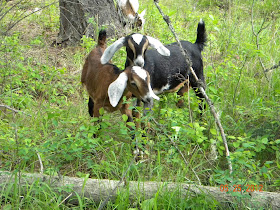Great Goat Information... SRN
Milk Quality and Flavor |
There are several factors that can affect both milk quality and flavor. Flavors in goat milk are often related to what the lactating doe eats. However, importance of corral and milking parlor hygiene, proper milking procedures and equipment maintenance, plus mastitis control and antibiotic residues, all can affect flavor and subsequent quality.
To reduce feed flavors in milk, eliminate moldy feeds and offer suspected feeds either soon after milking or at least 4 to 5 hours before the next milking time. Objectionable flavors from some feeds pass from the rumen and digestive tract, via blood, into the udder and milk. Odors from feedstuffs are breathed by the doe and pass from the lung, via the bloodstream, to the udder and into milk. Controlling intake of questionable feeds is not always easy, and the amount of time between feeding and milking sometimes needs some experimentation. The following lists give examples of various feedstuffs for goats.
Rancidity is characterized by a bitter, soap-like taste. To reduce potential rancidity, milk collection systems should have hermetically sealed joints. Otherwise, air injections can cause foaming that can lead to rancidity. Also, excessive "T" joints and elbows in the system can cause the problem. Increasing refrigeration capacity and/or the speed of cooling and maintaining cool temperature in the milk helps to reduce the problem. High bacteria numbers can aggravate the problem.
Beet tops and pulp
Little or No Feed Flavor With Normal Amounts
Carrots and green peas
Corn, barley and oats
Soybeans and cottonseed
Potatoes and pumpkins
Safflower and sunflower
Citrus and coconut
Most grasses and hay
Alfalfa (green, hay or silage)
Off-Flavor If Fed Within 5 Hrs. of Next Milking
Soybeans or corn silage
Rye and rape
Turnips, cabbage, kale
Green barley
Sweet clover (green, hay or silage)
Wild garlic and onions Mustard, marigold, flax
Common Weeds and Milk Off-Flavors
Chamomile and fennel
Daisy, cress and yarrow
Snake, sneeze and rag
Pepper, bitter and worts
Cocklebur and buckthorn
Wild lettuce and carrotOxidized flavor is characterized by a metallic or cardboard carton taste sensation. It is most commonly caused by milk coming in contact with copper surfaces, or alloys containing copper, in the milk handling system. Consequently, stainless steel and glass are the materials of choice. Plastic and rubber are acceptable but harder to keep clean. Feed does not cause oxidized flavor, but a ration with a large proportion of alfalfa hay can predispose the milk to oxidation. Prolonged exposure of milk to light and ultraviolet rays may also result in oxidation.
Chemical flavors in the milk often have a medicinal, sometimes "minty" taste. Prevention is best accomplished by following label instructions of disinfectants and cleaning agents used in sanitizing the milking system. This concerns both amount of sanitizer and duration of time it is used. Also, care is needed to properly clean and rinse equipment and to avoid chemical agent contact with milking equipment during the milking.
General hygiene in corrals, loafing barns, and the milking area can affect the flavor and quality of the milk.
This can occur through contact contamination of sediments on the udder, in milking equipment, and milk. Also, tests have shown that flavors can be transmitted from the environment to the udder within 15 minutes, by way of the respiratory tract. Goat inhaling of partially digested feed odors has also been reported as a possible cause of "goaty" milk flavor.
Another common cause of undesirable milk flavor is mastitis. This is mainly from the effect of mastitis on an increased salt and decreased sugar content in milk. Sometimes an insipid, flat, or watery taste can occur, or both salty and watery tastes can occur at the same time. Mastitis effects on milk flavor and the environmental hygiene situation have both been indicated as causes of "unclean" and/or "goaty" taste in milk.
Maintaining an appealing flavor in goat milk is a complex issue. An acceptable flavor to one consumer may not be acceptable to another. Likewise, some "off-flavors" are considered normal to persons that are used to a given smell and taste. The saying that dilution is the solution can only help to a limited point. Causes of objectionable flavors are cause for alarm if there is an increasing group of unhappy consumers.
GOATS:

No comments:
Post a Comment
Do To the enormous amounts of spam I will no longer take the time to moderate Anyone posting under anonymous... Sorry for the inconvenience but my email is blasted everyday with 40 to 50 anonymous posts that are junk mail. I just don't have the time to read each one before deleting.